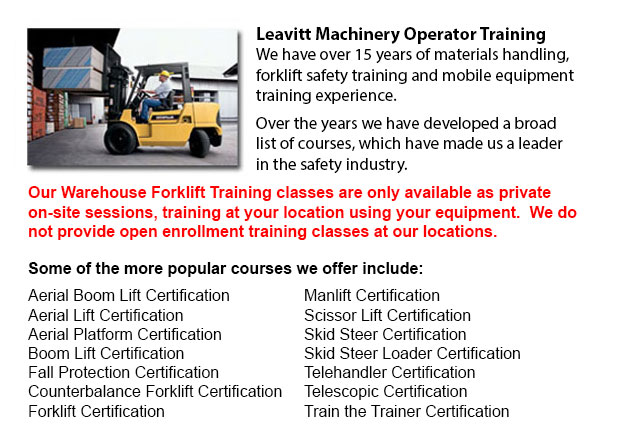
Brampton Warehouse Forklift Training Programs - Warehouses can be commercial, retail or industrial facilities. Their function could differ from product distribution to retailing bulk products. Regardless of the kind of warehouse, workers within warehouse settings must be well trained in safety measures related to material storage and handling, conveyor systems, loading docks, and pallet jacks and forklifts. Good housekeeping is vital to an orderly and safe warehouse environment.
The loading dock system is often build into the warehouse at a height from the ground making it easy to move things moving out and coming in of the warehouse. Staff would likewise load and unload merchandise and materials from the ramps and elevated docks. Particular attention should be paid to safety habits in this stage. To be able to prevent falls, install yellow striping along the edge of ramps and docks. Pay attention to the area all-around delivery trucks which are parked at the loading dock, especially the area between dock and the truck. Be certain that when unloading, truck wheels are chocked.
Some warehouses make use of conveyor systems to distribute products inside the facility. Conveyor systems have moving belts and wheels that pose a pinch point hazard. Keep hair and body parts far away from conveyors to prevent injury. Elevated conveyors pose a hazard to personnel beneath if safety nets are absent. Staff ought to know how to stop conveyors in the event of emergency. Be aware of the location of emergency stop buttons and off switches. When servicing conveyors, lock out/tag out measures are mandatory.
Forklifts and pallet jacks are designed to move materials around the warehouse. Forklift operators are needed to take training and be given certification. Operators of pallet jacks do not require certification, but must be trained about the machine. Training courses instruct operators in the proper methods for hoisting materials and transporting them to their assigned location. Neither forklifts nor pallet jacks should ever be used to lift or transport personnel.
To allow for adequate room for equipment and people to pass, rack systems and storage shelving help to create an efficient and orderly work space, specially if they are correctly braced. Slow and careful placement of good is needed to avoid accidents caused by products falling off the facing aisle. Aisles should be kept clear by storing products flat and inside the shelving units. Pallets are used for stacking products. They must be in good condition, and palleted products should be shrink-wrapped or baled, whenever possible.
PPE or also referred to as personal protective equipment should be worn when required to help protect the workers' limbs, heads, hands and feet. Bump caps or hard hats, steel-toed shoes and gloves are common PPE.
Slippery floors pocked with dents and pits present a danger. Good housekeeping habits include keeping warehouse docks and floors clear of debris, oil and dirt. The space must be kept clear of boxes, baling materials and trash.
-
Brampton Aerial Boom Lift Ticket
Brampton Aerial Boom Lift Ticket - Aerial lift trucks might be used to accomplish several different tasks executed in hard to reach aerial places. Many of the tasks associated with this style of jack include performing routine maintenance on building... More -
Brampton Aerial Lift Train the Trainer
Brampton Aerial Lift Train the Trainer - The Aerial Lifts Train the Trainer Certification Program would teach trainers how to efficiently train operators in safe industrial mobile equipment operation. Trainers are provided with in-depth instruction o... More -
Brampton Zoom Boom Training
Brampton Zoom Boom Training - Zoom Boom Training is intended to train operators on variable reach forklifts. The goals of the training are to be able to impart an understanding of the physics of the machinery, and to be able to outline the operator's... More -
Brampton Heavy Equipment Operator Training
Brampton Heavy Equipment Operator Training - Heavy equipment operator training facilities that provide good standards within the industry, providing field performance work and additional machinery training are really sought after training features. S... More -
Narrow Aisle Forklift / Order Picker Training / Electric Pallet Jack / Electric Pallet Truck Training in Brampton
A pallet haul is equipment built in particular for moving pallets of irregular weights and dimensions. They may be used in conjunction with cranes, forklifts and other heavy duty equipment as an appendage piece or to be employed on their own. Pallet... More -
Brampton Overhead Crane Safety Training
Brampton Overhead Crane Safety Training - Overhead crane safety training equips operators with knowledge and skills regarding crane safety measures, accident avoidance, materials handling, and equipment and stock protection. Trainees will learn the k... More -
Brampton Crane Safety Training
Brampton Crane Safety Training - Companies and crane drivers have to know the problems associated to crane safety. Legislation provides rules for the safe maintenance, operation and inspection of lifting machines across North America. Crane Safety co... More -
Brampton Telehandler Training
Brampton Telehandler Training - Telescopic handlers normally known as telehandlers for short, are a really popular piece of heavy construction machinery. They are usually utilized in the construction and agricultural trades. These machines have farth... More

Forklift Certification Brampton
TOLL FREE: 1-888-254-6157
Brampton, Ontario
forkliftcertificationbrampton.com
Email Us
About Us


